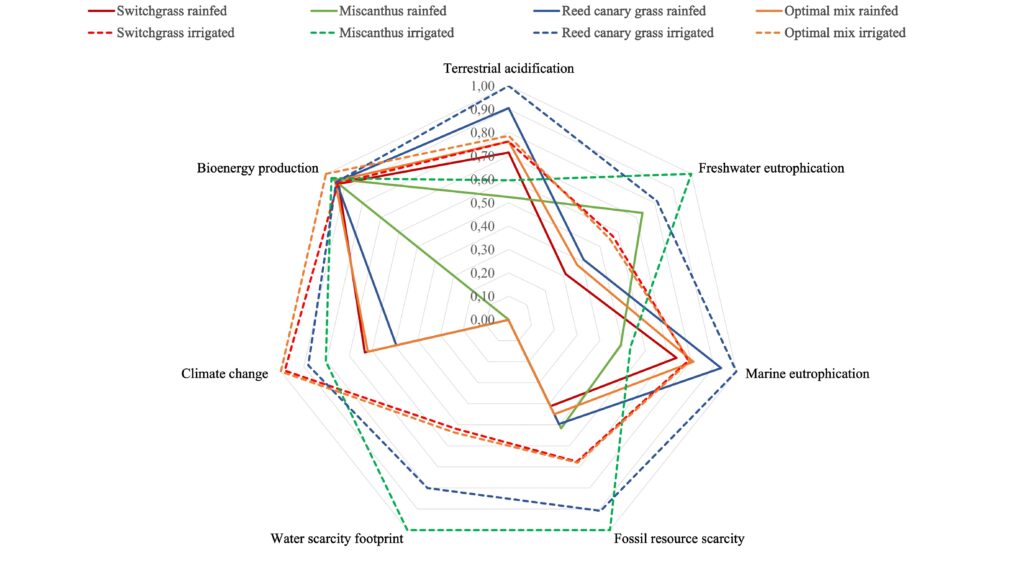Environmental impacts of perennial grasses on abandoned cropland in Europe
Perennial grasses cultivated on abandoned cropland for bioenergy production represent a sustainable approach to gradually expand bioenergy supply at reduced risks for land competition, food security and the environment. This study quantifies spatially explicit the primary energy potentials and associated potential environmental impacts of large-scale deployment of three perennial grasses (miscanthus, switchgrass, and reed canary grass), on abandoned cropland in Europe. Members of IEA Bioenergy Task 45 (Sustainability & Climate Change) were involved in this research.
The main conclusion of the research is that perennial grasses on abandoned agricultural land can absorb more CO2 into the soil than the GHGs released during their agricultural production and have potential to contribute to negative emissions while delivering a source of energy and/or materials.
The scientific paper is published in the Journal Environmental Impact Assessment Review, and is available in open access here:
Energy potentials, negative emissions, and spatially explicit environmental impacts of perennial grasses on abandoned cropland in Europe
Introduction
Climate change mitigation scenarios aiming to achieve the most stringent temperature targets rely on substantial amounts of bioenergy, also from dedicated crops. Perennial grasses are usually drought-resistant crops, they can be grown at lower input requirements than annual crops and they help to improve soil quality and restore land degradation processes. Due to their perennial nature, tillage and maintenance operation needs are lower when compared with annual crops. In addition, they may have positive environmental effects on restoring degraded land through reduced soil erosion and improved soil quality as well as increasing biodiversity by providing habitat for birds and insects. Reduced soil disturbance from limited tillage, along with their deep root system, allows for high water use efficiency, recycling of nutrients and increases soil organic carbon (SOC), which further mitigates climate change.
Growing perennial grasses for bioenergy production on abandoned cropland has emerged as a sustainable approach to gradually expand bioenergy supply at reduced risks for land competition, food security and the environment. Agricultural abandonment is widespread in many regions of the world, including Europe, and it is driven by a combination of many socio-economic, political, and environmental factors that undermine the profitability of formerly cultivated fields. Studies analysing the main drivers and causes of cropland abandonment in Europe usually find that the abandonment process is mostly due to socioeconomic factors, such as economic growth, exposure to international markets and migration to urban areas, rather than declines in soil quality and fertility.
Approach
Abandoned cropland in Europe is mapped using satellite-based land cover maps. Spatially explicit yields for three perennial grasses (miscanthus, switchgrass, and reed canary grass) are estimated from a gridded agro-ecological crop yield model for high intensity agricultural management and two water supply scenarios (rainfed and irrigated) and two additional cases for energy-based optimal crop mix. Spatially explicit environmental performances are assessed from a life-cycle perspective using gridded-specific life-cycle inventories in reference to the local yield.
Soil organic carbon changes after establishment of the perennial grasses are modelled using a model based on site-specific climatic parameters.
Conclusions
Annual bioenergy potentials from perennial grasses cultivated on abandoned cropland range from 1 EJ to about 7 EJ in Europe. The optimal crop mix with irrigation can produce the maximum bioenergy potential (about 7 EJ/yr) which corresponds to about 10% of the total primary energy consumption in Europe. This is nearly equivalent to the current use of bioenergy in Europe.
The benefits from irrigation are two-fold: higher yields and expansion of areas suitable for farming. Irrigation increases land suitability for all grasses up to about 95% of the total available abandoned cropland in Europe (16.2 Mha). The impacts on climate change from the agricultural phase increase as well, however, this is more than compensated by increases in soil organic carbon. Important consideration for irrigation deployment is the local water availability and storage capacity.
The net annual climate change impacts, calculated as the sum of the climate change impacts from life-cycle emission and soil organic carbon changes, are negative for all crops under rainfed conditions. For miscanthus, negative emissions are also achieved when irrigation is used. Thus, perennial grasses on abandoned agricultural land can absorb more CO2 into the soil than the GHGs released during their agricultural production and have potential to contribute to negative emissions while delivering a source of energy and/or materials. The averages of annual SOC stock changes are the highest for reed canary grass (5.1 tCO2eq/ha), followed by switchgrass (4.5 tCO2eq./ha) and miscanthus (4.1 tCO2eq./ha).

Figure: Overview of co-benefits and trade-offs of growing perennial grasses on abandoned cropland in Europe for the average scores. Results for each of the eight scenarios are normalized relative to the highest impact, using the average results. A score of 1 indicates the worst relative performance for the environmental impacts. For bioenergy potentials, 1 indicates the maximum value.
Citation: Iordan, Cristina-Maria, Baptiste Giroux, Jan Sandstad Næss, Xiangping Hu, Otávio Cavalett, and Francesco Cherubini. “Energy potentials, negative emissions, and spatially explicit environmental impacts of perennial grasses on abandoned cropland in Europe.” Environmental Impact Assessment Review 98 (2023): 106942. https://doi.org/10.1016/j.eiar.2022.106942


